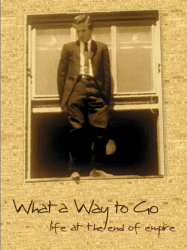Five Ways to Save the World est un film Britannique de genre Documentaire
Five Ways to Save the World (2006)

Si vous aimez ce film, faites-le savoir !
- Infos
- Casting
- Infos techniques
- Photos
- Vidéos
- Passages TV
- Citations
- Personnages
- Musique
- Récompenses
OrigineRoyaume-uni
Genres Documentaire
Five Ways to Save the World is a British documentary film on environmental issues related to climate change, released in 2006. The film was made by Karen O'Connor, for the big screen and was shot in the English language to reach an international audience. It includes interviews with five environmental scientists and experts including Paul Crutzen, James Roger Angel, John Latham, Ian Jones, and Klaus Lackner.
The "five ways" proposed are geoengineering techniques:
space lenses in orbit, to diffract sunlight away from the earth
cloud seeding with seawater to increase albedo
sulfur launched into the stratosphere to increase albedo
ocean fertilization with iron or urea (nitrogen fertilizer)
artificial trees (see carbon capture and sequestration)
Since the first three methods do not remove carbon dioxide from the atmosphere, they would only reduce global warming but not ocean acidification. Since the last two methods would remove carbon dioxide, they could in theory reduce both global warming and ocean acidification.
Commentaires
Postez un commentaire :
Suggestions de films similaires à Five Ways to Save the World
Il y a 8965 ayant les mêmes genres cinématographiques, 2491 films qui ont les mêmes thèmes (dont 43 films qui ont les mêmes 3 thèmes que Five Ways to Save the World), pour avoir au final 70 suggestions de films similaires.Si vous avez aimé Five Ways to Save the World, vous aimerez sûrement les films similaires suivants :

Dams: The Lethal Water Bombs (2011)
, 21minutesRéalisé par Sohan Roy
Genres Documentaire
Thèmes L'environnement, Documentaire sur l'environnement, Documentaire historique, Documentaire sur les technologies, Film catastrophe
Note72%





The Banqiao Dam in China, with its 492 million cubic meters of water, has a similar capacity to the Mullaperiyar Dam, with 443 million cubic meters. When it was destroyed by torrential rains in 1975, it claimed the lives of 250,000 people. This documentary is based on the possibility of a similar disaster happening to the Mullaperiyar Dam in India.
 , 2h3
, 2h3Origine Etats-Unis
Genres Documentaire
Thèmes L'environnement, Documentaire sur l'environnement, Documentaire sur la politique, Documentaire sur les technologies, Politique, Film catastrophe
Acteurs Daniel Quinn
Note75%






Black Wind, White Land (1993)
, 53minutesGenres Documentaire
Thèmes L'environnement, Documentaire sur l'environnement, Documentaire historique, Documentaire sur le nucléaire, Documentaire sur les technologies, Film catastrophe

The Unnamed Zone (2006)
, 1h20Réalisé par Carlos Rodríguez
Genres Documentaire
Thèmes L'environnement, Documentaire sur l'environnement, Documentaire historique, Documentaire sur le nucléaire, Documentaire sur les technologies, Film catastrophe
Note63%





The Spanish film crew led by Carlos Rodriguez is following the life stories of three children - Lidia Pidvalna, Anastasia Pavlenko, and Andriy Kovalchuk - whose lives were drastically changed after an explosion at the Chernobyl Nuclear Power Station on April 26, 1986. Through the documentary, the children and their families "living perilously close to the exclusion zone around the destroyed station recount their fears, dreams, fantasies, and hopes for the future." Each child holds a "Chernobyl certificate" which bestows access to government grants and aid and is a gruesome reminder of their existential reality.

Everything's Cool (2007)
Genres Documentaire
Thèmes L'environnement, Documentaire sur l'environnement, Film catastrophe
Acteurs Leonardo DiCaprio, Bill Maher, Oprah Winfrey
Note67%






Les Yes Men se révoltent (2014)
, 1h31Genres Documentaire
Thèmes L'environnement, Documentaire sur l'environnement, Film catastrophe
Note66%





Les «Yes Men», le duo formé par Jacques Servin et Igor Vamos, alias Mike Bonanno et Andy Bichlbaum, dénoncent l'état du monde depuis deux décennies avec leurs sketchs, leurs dossiers de presse bidon et leurs fausses bonnes nouvelles. Ciblant les multinationales et les États complices, ferraillant contre la surexploitation des hommes et des ressources naturelles, ils s'en prennent ici au ministre canadien de l'Environnement, à la Chambre de commerce américaine et aux géants du pétrole Shell et Gazprom. En se faisant passer pour des dirigeants politiques, ils interviennent aussi par exemple dans un congrès pour annoncer que le gouvernement américain renonce aux énergies fossiles au profit des énergies renouvelables

Чорнобиль.3828 (2011)
, 30minutesOrigine Ukraine
Genres Documentaire, Historique
Thèmes L'environnement, Documentaire sur l'environnement, Documentaire historique, Documentaire sur le nucléaire, Documentaire sur les technologies, Film catastrophe
Note74%





Twenty-five years have passed since Valeriy Starodumov worked as a dosimeter scout in September 1986. Valeriy worked at the epicenter of the explosion, the reactor's operation area, which was the most radioactive part of the site. The protagonist, a direct participant in the operation, went to the roof himself and brought people there after a failed attempt to clear the area with robots. At the government level, it was decided to assign soldiers and cadets of military schools to the task of cleaning the roofs. Unique pictures of the events of 1986 are widely used in the film. "Chernobyl.3828" is dedicated to people who saved the world from the radioactive contamination at the cost of their health and life.

Tout peut changer (2015)
, 1h29Genres Documentaire
Thèmes L'environnement, Documentaire sur l'environnement, Film catastrophe
Acteurs Naomi Klein
Note63%





 , 1h32
, 1h32Origine Etats-Unis
Genres Drame, Documentaire, Policier
Thèmes L'environnement, Documentaire sur l'environnement, Film catastrophe
Acteurs Leonardo DiCaprio
Note71%





Un regard sur l'état de l'environnement et des solutions pour tenter de restaurer l'écosystème planétaire, à travers des rencontres avec une cinquantaine de scientifiques, intellectuels et leaders politiques.

Origine Etats-Unis
Genres Documentaire
Thèmes L'environnement, Documentaire sur l'environnement, Film catastrophe
 Connexion
Connexion